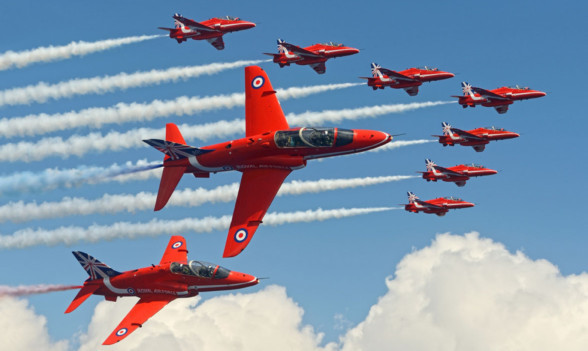
For the past 50 summers, the famous Red Arrows team has been leaving intricate vapour trails in their wake to whoops and gasps from the crowds below.
As the public face of the Royal Air Force, the Red Arrows boast some of the greatest pilots in the world. The team were one of the stunning highlights at the Commonwealth Games Opening Ceremony.
They headlined proceedings at Scotland’s National Airshow in East Fortune yesterday and feature in a new BBC Two documentary, The Red Arrows: Inside The Bubble, at 9pm tonight.
We spoke to one of three Scottish-born pilots currently in the Red Arrows’ ranks to unearth some little-known facts about the history and inner workings of the spectacular flying unit.
Flight Lieutenant Martin Pert, originally from Paisley, flies Red 8. The 33-year-old gained his private pilot’s licence aged 17 and joined the RAF in 2000. He has served on operations in Afghanistan and is in his third and final year in the Red Arrows.
He said: “My aspiration was always to be a fast-jet pilot but it wasn’t until I joined the RAF that I realised joining the Red Arrows might be achievable.
“There’s a pressure on the front line of supporting others, but the pressure with the Red Arrows is more self-induced to produce the absolute best we can.”
The team trains five days a week from October until May in preparation for the summer display season.
“During the training period we tend to find ourselves in bed by 9pm, completely exhausted, due to the intense concentration required when flying. We train three times a day, 35 minutes at a time, for five days a week.
“Every year when we start training, we’re wide-eyed and nervous about what we’re trying to do by May, not because of the manoeuvres but just the level of training required.”
Some of Martin’s favourite moments include the Olympic opening ceremony fly-past and the recent Armed Forces Day in Stirling. He’ll be stationed to Lossiemouth once his Red Arrows service comes to an end after the summer.
“I’ve loved it. We do pinch ourselves at times, because we remember the thrill we had of watching the Red Arrows as kids.”
20 FACTS ABOUT THE RED ARROWS
In 1964 the RAF amalgamated its display teams into one premier unit the Red Arrows. The name was taken from the Black Arrows team and the colour scheme as a tribute to the Red Pelicans.
A media event on May 6, 1965 was the team’s first official display.
In its first season, 1965, the team at that time seven aircraft performed 65 shows.
RAF Scampton, the station famous for its role in the 1943 Dambusters raid, became the team’s home in 1983.
The 2013 Middle East tour saw 15 displays and was transited through 10 countries.
The Red Arrows have, up to the start of the 2014 season, displayed in 55 countries.
The team is made up of 120 people, including pilots, engineers and essential support staff.
Pilots complete a three-year tour with the team, before returning to front line, instructional or staff duties.
A shortlist of nine applicants is examined each year, with two or three new pilots chosen.
Pilots must have completed a front line tour and have at least 1,500 fast jet flying hours.
Each of the Red Arrows’ aircraft is looked after by its own designated engineer for the display season.
The Red Arrows fly BAE Systems’ Hawk T1, powered by a Rolls Royce engine. It has a top speed of Mach 1.2.
The team receive more than 800 requests a year to perform, but usually do 75 to 80 displays in a summer season.
The full display for 2014 is made up of 24 manoeuvres.
The famous coloured smoke doesn’t just look good, it allows the pilots to judge wind speed and direction.
The smoke is created by injecting diesel into the hot exhaust, vaporising it at 400 degrees centigrade. The coloured trails are made by mixing the diesel with a dye stored in a pod.
Specialist survival equipment worn by the pilots includes an oxygen mask, flame retardant boots and trousers that prevent blood rushing to the legs during manoeuvres.
The team’s motto is Eclat, meaning excellence.
The 4,500th Red Arrows display took place at the RAF Waddington International Air Show in July 2013.
To mark the 50th season, the team’s aircraft have a new Union flag tailfin design.

Enjoy the convenience of having The Sunday Post delivered as a digital ePaper straight to your smartphone, tablet or computer.
Subscribe for only £5.49 a month and enjoy all the benefits of the printed paper as a digital replica.
Subscribe